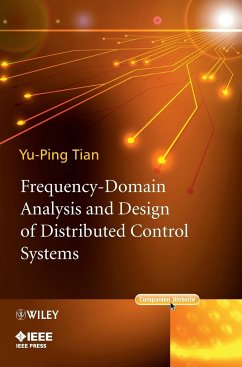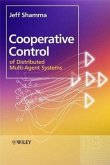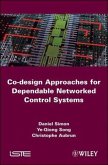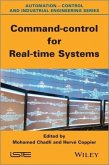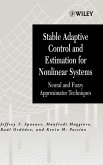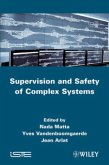Yu-Ping Tian
Frequency-Domain Analysis and Design of Distributed Control Systems
Yu-Ping Tian
Frequency-Domain Analysis and Design of Distributed Control Systems
- Gebundenes Buch
- Merkliste
- Auf die Merkliste
- Bewerten Bewerten
- Teilen
- Produkt teilen
- Produkterinnerung
- Produkterinnerung
With the rapid development of micro-sensors, micro-motors, sensor networks and communication networks, spatially distributed control systems have attracted increasing attention. Internet congestion control and the multi-robot coordination control are two typical examples of distributed control systems. In such systems global collective behaviors emerge or global targets are reached through a distributed control strategy. In Frequency-Domain Analysis and Design of Distributed Control Systems, Yu-Ping Tian systematically covers distributed control to help readers solve the effects of delays on…mehr
Andere Kunden interessierten sich auch für
![Cooperative Control of Distributed Multi-Agent Systems Cooperative Control of Distributed Multi-Agent Systems]() Jeff Shamma (ed.)Cooperative Control of Distributed Multi-Agent Systems256,99 €
Jeff Shamma (ed.)Cooperative Control of Distributed Multi-Agent Systems256,99 €![Co-Design Approaches for Dependable Networked Control Systems Co-Design Approaches for Dependable Networked Control Systems]() Daniel SimonCo-Design Approaches for Dependable Networked Control Systems194,99 €
Daniel SimonCo-Design Approaches for Dependable Networked Control Systems194,99 €![Command-Control for Real-Time Systems Command-Control for Real-Time Systems]() Command-Control for Real-Time Systems186,99 €
Command-Control for Real-Time Systems186,99 €![Fuzzy Control Systems Design and Analysis Fuzzy Control Systems Design and Analysis]() Kazuo TanakaFuzzy Control Systems Design and Analysis226,99 €
Kazuo TanakaFuzzy Control Systems Design and Analysis226,99 €![Stable Adaptive Control and Estimation for Nonlinear Systems Stable Adaptive Control and Estimation for Nonlinear Systems]() Jeffrey T. SpoonerStable Adaptive Control and Estimation for Nonlinear Systems206,99 €
Jeffrey T. SpoonerStable Adaptive Control and Estimation for Nonlinear Systems206,99 €![Dynamic Modeling and Predictive Control in Solid Oxide Fuel Cells Dynamic Modeling and Predictive Control in Solid Oxide Fuel Cells]() Biao HuangDynamic Modeling and Predictive Control in Solid Oxide Fuel Cells173,99 €
Biao HuangDynamic Modeling and Predictive Control in Solid Oxide Fuel Cells173,99 €![Supervision and Safety of Complex Systems Supervision and Safety of Complex Systems]() Supervision and Safety of Complex Systems213,99 €
Supervision and Safety of Complex Systems213,99 €-
-
-
With the rapid development of micro-sensors, micro-motors, sensor networks and communication networks, spatially distributed control systems have attracted increasing attention. Internet congestion control and the multi-robot coordination control are two typical examples of distributed control systems. In such systems global collective behaviors emerge or global targets are reached through a distributed control strategy. In Frequency-Domain Analysis and Design of Distributed Control Systems, Yu-Ping Tian systematically covers distributed control to help readers solve the effects of delays on stability.
The first book to introduce frequency-domain methods for the analysis of distributed control systems, covering:
Scalable stability criteria of networks of distributed control systems
Effect of heterogeneous delays on the stability of a network of distributed control systems
Stability of Internet congestion control algorithms
Consensus in multi-agent systems
Introduces control design problems related to frequency domain analysis
PowerPoint slides with book figures available for instructor use
This book is ideal for graduate students in control, networking and robotics. The book is also geared for researchers in the fields of control theory and networking, who are interested in learning and applying distributed control algorithms or frequency-domain analysis methods.
Companion website for the book:
www.wiley.com/go/tian/fda
Hinweis: Dieser Artikel kann nur an eine deutsche Lieferadresse ausgeliefert werden.
The first book to introduce frequency-domain methods for the analysis of distributed control systems, covering:
Scalable stability criteria of networks of distributed control systems
Effect of heterogeneous delays on the stability of a network of distributed control systems
Stability of Internet congestion control algorithms
Consensus in multi-agent systems
Introduces control design problems related to frequency domain analysis
PowerPoint slides with book figures available for instructor use
This book is ideal for graduate students in control, networking and robotics. The book is also geared for researchers in the fields of control theory and networking, who are interested in learning and applying distributed control algorithms or frequency-domain analysis methods.
Companion website for the book:
www.wiley.com/go/tian/fda
Hinweis: Dieser Artikel kann nur an eine deutsche Lieferadresse ausgeliefert werden.
Produktdetails
- Produktdetails
- Verlag: Wiley & Sons
- 1. Auflage
- Seitenzahl: 288
- Erscheinungstermin: 6. November 2012
- Englisch
- Abmessung: 250mm x 175mm x 20mm
- Gewicht: 594g
- ISBN-13: 9780470828205
- ISBN-10: 047082820X
- Artikelnr.: 36267331
- Herstellerkennzeichnung
- Libri GmbH
- Europaallee 1
- 36244 Bad Hersfeld
- gpsr@libri.de
- Verlag: Wiley & Sons
- 1. Auflage
- Seitenzahl: 288
- Erscheinungstermin: 6. November 2012
- Englisch
- Abmessung: 250mm x 175mm x 20mm
- Gewicht: 594g
- ISBN-13: 9780470828205
- ISBN-10: 047082820X
- Artikelnr.: 36267331
- Herstellerkennzeichnung
- Libri GmbH
- Europaallee 1
- 36244 Bad Hersfeld
- gpsr@libri.de
Yu-Ping Tian is a Professor of Automation at Southeast University. His research interests include analysis and control of communication networks, formation control of robots, chaos control and synchronization, and robust and adaptive control. He won the Guan Zhao Zhi Paper Award at the Chinese Control Conference in 1995 and the Best Theory Paper Award at the 3rd World Congress on Intelligent Control and Automation in 2000. He is the recipient of the Chang Jiang Professorship awarded by the Education Ministry of China and the Distinguished Young Scholar Award of the National Natural Science Foundation of China. He has held visiting positions in Central Queensland University (1998, 2001), University of California at Berkeley (2002), and City University of Hong Kong (2004). Tian received a Bachelors degree from Tsinghua University, a Ph.D. degree from Moscow Power Institute and an Sc.D. degree from Taganrog State Radio-engineering University, Taganrog, Russia, in 1996. All his degrees are in Electrical Engineering.
Preface xi
Glossary of Symbols xiii
1 Introduction 1
1.1 Network-Based Distributed Control System 1
1.2 Graph Theory and Interconnection Topology 4
1.2.1 Basic Definitions 4
1.2.2 Graph Operations 7
1.2.3 Algebraic Graph Theory 10
1.3 Distributed Control Systems 16
1.3.1 End-to-End Congestion Control Systems 16
1.3.2 Consensus-Based Formation Control 22
1.4 Notes and References 25
1.4.1 Graph Theory and Distributed Control Systems 25
1.4.2 Delay in Control and Control by Delay 26
References 26
2 Symmetry, Stability and Scalability 31
2.1 System Model 31
2.1.1 Graph-Based Model of Distributed Control Systems 31
2.1.2 Bipartite Distributed Control Systems 34
2.2 Symmetry in the Frequency Domain 36
2.2.1 Symmetric Systems 36
2.2.2 Symmetry of Bipartite Systems 38
2.3 Stability of Multivariable Systems 39
2.3.1 Poles and Stability 39
2.3.2 Zeros and Pole-Zero Cancelation 41
2.4 Frequency-Domain Criteria of Stability 43
2.4.1 Loop Transformation and Multiplier 44
2.4.2 Multivariable Nyquist Stability Criterion 45
2.4.3 Spectral Radius Theorem and Small-Gain Theorem 50
2.4.4 Positive Realness Theorem 53
2.5 Scalable Stability Criteria 53
2.5.1 Estimation of Spectrum of Complex Matrices 53
2.5.2 Scalable Stability Criteria for Asymmetric Systems 56
2.5.3 Scalable Stability Criteria for Symmetric Systems 60
2.5.4 Robust Stability in Deformity of Symmetry 61
2.6 Notes and References 64
References 65
3 Scalability in the Frequency Domain 67
3.1 How the Scalability Condition is Related with Frequency Responses 67
3.2 Clockwise Property of Parameterized Curves 71
3.3 Scalability of First-Order Systems 76
3.3.1 Continuous-Time System 76
3.3.2 Discrete-Time System 79
3.4 Scalability of Second-Order Systems 85
3.4.1 System of Type I 85
3.4.2 System of Type II 95
3.5 Frequency-Sweeping Condition 103
3.5.1 Stable Quasi-Polynomials 103
3.5.2 Frequency-Sweeping Test 105
3.6 Notes and References 108
References 109
4 Congestion Control: Model and Algorithms 111
4.1 An Introduction to Congestion Control 111
4.1.1 Congestion Collapse 112
4.1.2 Efficiency and Fairness 114
4.1.3 Optimization-Based Resource Allocation 114
4.2 Distributed Congestion Control Algorithms 116
4.2.1 Penalty Function Approach and Primal Algorithm 116
4.2.2 Dual Approach and Dual Algorithm 117
4.2.3 Primal-Dual Algorithm 118
4.2.4 REM: A Second-Order Dual Algorithm 118
4.3 A General Model of Congestion Control Systems 119
4.3.1 Framework of End-to-End Congestion Control under Diverse Round-Trip
Delays 119
4.3.2 General Primal-Dual Algorithm 122
4.3.3 Frequency-Domain Symmetry of Congestion Control Systems 124
4.4 Notes and References 126
References 127
5 Congestion Control: Stability and Scalability 129
5.1 Stability of the Primal Algorithm 129
5.1.1 Johari-Tan Conjecture 129
5.1.2 Scalable Stability Criterion for Discrete-Time Systems 131
5.1.3 Scalable Stability Criterion for Continuous-Time Systems 135
5.2 Stability of REM 138
5.2.1 Scalable Stability Criteria 138
5.2.2 Dual Algorithm: the First-Order Limit Form of REM 145
5.2.3 Design of Parameters of REM 146
5.3 Stability of the Primal-Dual Algorithm 152
5.3.1 Scalable Stability Criteria 152
5.3.2 Proof of the Stability Criteria 161
5.4 Time-Delayed Feedback Control 163
5.4.1 Time-Delayed State as a Reference 163
5.4.2 TDFC for Stabilization of an Unknown Equilibrium 165
5.4.3 Limitation of TDFC in Stabilization 166
5.5 Stabilization of Congestion Control Systems by Time-Delayed
Feedback Control 170
5.5.1 Introduction of TDFC into Distributed Congestion Control Systems 170
5.5.2 Stabilizability under TDFC 171
5.5.3 Design of TDFC with Commensurate Self-Delays 181
5.6 Notes and References 188
5.6.1 Stability of Congestion Control with Propagation Delays 188
5.6.2 Time-Delayed Feedback Control 189
References 190
6 Consensus in Homogeneous Multi-Agent Systems 193
6.1 Introduction to Consensus Problem 193
6.1.1 Integrator Agent System 193
6.1.2 Existence of Consensus Solution 194
6.1.3 Consensus as a Stability Problem 194
6.1.4 Discrete-Time Systems 195
6.1.5 Consentability 195
6.2 Second-Order Agent System 196
6.2.1 Consensus and Stability 196
6.2.2 Consensus and Consentability Condition 199
6.2.3 Periodic Consensus Solutions 203
6.2.4 Simulation Study 204
6.3 High-Order Agent System 206
6.3.1 System Model 206
6.3.2 Consensus Condition 208
6.3.3 Consentability 211
6.4 Notes and References 216
References 217
7 Consensus in Heterogeneous Multi-Agent Systems 219
7.1 Integrator Agent System with Diverse Input and Communication Delays 219
7.1.1 Consensus in Discrete-Time Systems 220
7.1.2 Consensus under Diverse Input Delays 221
7.1.3 Consensus under Diverse Communication Delays and Input Delays 224
7.1.4 Continuous-Time System 229
7.1.5 Simulation Study 230
7.2 Double Integrator System with Diverse Input Delays and Interconnection
Uncertainties 233
7.2.1 Leader-Following Consensus Algorithm 233
7.2.2 Consensus Condition under Symmetric Coupling Weights 235
7.2.3 Robust Consensus under Asymmetric Perturbations 238
7.2.4 Simulation Study 240
7.3 High-Order Consensus in High-Order Systems 243
7.3.1 System Model 243
7.3.2 Consensus Condition 245
7.3.3 Existence of High-Order Consensus Solutions 249
7.3.4 Constant Consensus 252
7.3.5 Consensus in Ideal Networks 254
7.4 Integrator-Chain Systems with Diverse Communication Delays 255
7.4.1 Matching Condition for Self-Delay 255
7.4.2 Adaptive Adjustment of Self-Delay 255
7.4.3 Simulation Study 257
7.5 Notes and References 265
References 266
Index 269
Glossary of Symbols xiii
1 Introduction 1
1.1 Network-Based Distributed Control System 1
1.2 Graph Theory and Interconnection Topology 4
1.2.1 Basic Definitions 4
1.2.2 Graph Operations 7
1.2.3 Algebraic Graph Theory 10
1.3 Distributed Control Systems 16
1.3.1 End-to-End Congestion Control Systems 16
1.3.2 Consensus-Based Formation Control 22
1.4 Notes and References 25
1.4.1 Graph Theory and Distributed Control Systems 25
1.4.2 Delay in Control and Control by Delay 26
References 26
2 Symmetry, Stability and Scalability 31
2.1 System Model 31
2.1.1 Graph-Based Model of Distributed Control Systems 31
2.1.2 Bipartite Distributed Control Systems 34
2.2 Symmetry in the Frequency Domain 36
2.2.1 Symmetric Systems 36
2.2.2 Symmetry of Bipartite Systems 38
2.3 Stability of Multivariable Systems 39
2.3.1 Poles and Stability 39
2.3.2 Zeros and Pole-Zero Cancelation 41
2.4 Frequency-Domain Criteria of Stability 43
2.4.1 Loop Transformation and Multiplier 44
2.4.2 Multivariable Nyquist Stability Criterion 45
2.4.3 Spectral Radius Theorem and Small-Gain Theorem 50
2.4.4 Positive Realness Theorem 53
2.5 Scalable Stability Criteria 53
2.5.1 Estimation of Spectrum of Complex Matrices 53
2.5.2 Scalable Stability Criteria for Asymmetric Systems 56
2.5.3 Scalable Stability Criteria for Symmetric Systems 60
2.5.4 Robust Stability in Deformity of Symmetry 61
2.6 Notes and References 64
References 65
3 Scalability in the Frequency Domain 67
3.1 How the Scalability Condition is Related with Frequency Responses 67
3.2 Clockwise Property of Parameterized Curves 71
3.3 Scalability of First-Order Systems 76
3.3.1 Continuous-Time System 76
3.3.2 Discrete-Time System 79
3.4 Scalability of Second-Order Systems 85
3.4.1 System of Type I 85
3.4.2 System of Type II 95
3.5 Frequency-Sweeping Condition 103
3.5.1 Stable Quasi-Polynomials 103
3.5.2 Frequency-Sweeping Test 105
3.6 Notes and References 108
References 109
4 Congestion Control: Model and Algorithms 111
4.1 An Introduction to Congestion Control 111
4.1.1 Congestion Collapse 112
4.1.2 Efficiency and Fairness 114
4.1.3 Optimization-Based Resource Allocation 114
4.2 Distributed Congestion Control Algorithms 116
4.2.1 Penalty Function Approach and Primal Algorithm 116
4.2.2 Dual Approach and Dual Algorithm 117
4.2.3 Primal-Dual Algorithm 118
4.2.4 REM: A Second-Order Dual Algorithm 118
4.3 A General Model of Congestion Control Systems 119
4.3.1 Framework of End-to-End Congestion Control under Diverse Round-Trip
Delays 119
4.3.2 General Primal-Dual Algorithm 122
4.3.3 Frequency-Domain Symmetry of Congestion Control Systems 124
4.4 Notes and References 126
References 127
5 Congestion Control: Stability and Scalability 129
5.1 Stability of the Primal Algorithm 129
5.1.1 Johari-Tan Conjecture 129
5.1.2 Scalable Stability Criterion for Discrete-Time Systems 131
5.1.3 Scalable Stability Criterion for Continuous-Time Systems 135
5.2 Stability of REM 138
5.2.1 Scalable Stability Criteria 138
5.2.2 Dual Algorithm: the First-Order Limit Form of REM 145
5.2.3 Design of Parameters of REM 146
5.3 Stability of the Primal-Dual Algorithm 152
5.3.1 Scalable Stability Criteria 152
5.3.2 Proof of the Stability Criteria 161
5.4 Time-Delayed Feedback Control 163
5.4.1 Time-Delayed State as a Reference 163
5.4.2 TDFC for Stabilization of an Unknown Equilibrium 165
5.4.3 Limitation of TDFC in Stabilization 166
5.5 Stabilization of Congestion Control Systems by Time-Delayed
Feedback Control 170
5.5.1 Introduction of TDFC into Distributed Congestion Control Systems 170
5.5.2 Stabilizability under TDFC 171
5.5.3 Design of TDFC with Commensurate Self-Delays 181
5.6 Notes and References 188
5.6.1 Stability of Congestion Control with Propagation Delays 188
5.6.2 Time-Delayed Feedback Control 189
References 190
6 Consensus in Homogeneous Multi-Agent Systems 193
6.1 Introduction to Consensus Problem 193
6.1.1 Integrator Agent System 193
6.1.2 Existence of Consensus Solution 194
6.1.3 Consensus as a Stability Problem 194
6.1.4 Discrete-Time Systems 195
6.1.5 Consentability 195
6.2 Second-Order Agent System 196
6.2.1 Consensus and Stability 196
6.2.2 Consensus and Consentability Condition 199
6.2.3 Periodic Consensus Solutions 203
6.2.4 Simulation Study 204
6.3 High-Order Agent System 206
6.3.1 System Model 206
6.3.2 Consensus Condition 208
6.3.3 Consentability 211
6.4 Notes and References 216
References 217
7 Consensus in Heterogeneous Multi-Agent Systems 219
7.1 Integrator Agent System with Diverse Input and Communication Delays 219
7.1.1 Consensus in Discrete-Time Systems 220
7.1.2 Consensus under Diverse Input Delays 221
7.1.3 Consensus under Diverse Communication Delays and Input Delays 224
7.1.4 Continuous-Time System 229
7.1.5 Simulation Study 230
7.2 Double Integrator System with Diverse Input Delays and Interconnection
Uncertainties 233
7.2.1 Leader-Following Consensus Algorithm 233
7.2.2 Consensus Condition under Symmetric Coupling Weights 235
7.2.3 Robust Consensus under Asymmetric Perturbations 238
7.2.4 Simulation Study 240
7.3 High-Order Consensus in High-Order Systems 243
7.3.1 System Model 243
7.3.2 Consensus Condition 245
7.3.3 Existence of High-Order Consensus Solutions 249
7.3.4 Constant Consensus 252
7.3.5 Consensus in Ideal Networks 254
7.4 Integrator-Chain Systems with Diverse Communication Delays 255
7.4.1 Matching Condition for Self-Delay 255
7.4.2 Adaptive Adjustment of Self-Delay 255
7.4.3 Simulation Study 257
7.5 Notes and References 265
References 266
Index 269
Preface xi
Glossary of Symbols xiii
1 Introduction 1
1.1 Network-Based Distributed Control System 1
1.2 Graph Theory and Interconnection Topology 4
1.2.1 Basic Definitions 4
1.2.2 Graph Operations 7
1.2.3 Algebraic Graph Theory 10
1.3 Distributed Control Systems 16
1.3.1 End-to-End Congestion Control Systems 16
1.3.2 Consensus-Based Formation Control 22
1.4 Notes and References 25
1.4.1 Graph Theory and Distributed Control Systems 25
1.4.2 Delay in Control and Control by Delay 26
References 26
2 Symmetry, Stability and Scalability 31
2.1 System Model 31
2.1.1 Graph-Based Model of Distributed Control Systems 31
2.1.2 Bipartite Distributed Control Systems 34
2.2 Symmetry in the Frequency Domain 36
2.2.1 Symmetric Systems 36
2.2.2 Symmetry of Bipartite Systems 38
2.3 Stability of Multivariable Systems 39
2.3.1 Poles and Stability 39
2.3.2 Zeros and Pole-Zero Cancelation 41
2.4 Frequency-Domain Criteria of Stability 43
2.4.1 Loop Transformation and Multiplier 44
2.4.2 Multivariable Nyquist Stability Criterion 45
2.4.3 Spectral Radius Theorem and Small-Gain Theorem 50
2.4.4 Positive Realness Theorem 53
2.5 Scalable Stability Criteria 53
2.5.1 Estimation of Spectrum of Complex Matrices 53
2.5.2 Scalable Stability Criteria for Asymmetric Systems 56
2.5.3 Scalable Stability Criteria for Symmetric Systems 60
2.5.4 Robust Stability in Deformity of Symmetry 61
2.6 Notes and References 64
References 65
3 Scalability in the Frequency Domain 67
3.1 How the Scalability Condition is Related with Frequency Responses 67
3.2 Clockwise Property of Parameterized Curves 71
3.3 Scalability of First-Order Systems 76
3.3.1 Continuous-Time System 76
3.3.2 Discrete-Time System 79
3.4 Scalability of Second-Order Systems 85
3.4.1 System of Type I 85
3.4.2 System of Type II 95
3.5 Frequency-Sweeping Condition 103
3.5.1 Stable Quasi-Polynomials 103
3.5.2 Frequency-Sweeping Test 105
3.6 Notes and References 108
References 109
4 Congestion Control: Model and Algorithms 111
4.1 An Introduction to Congestion Control 111
4.1.1 Congestion Collapse 112
4.1.2 Efficiency and Fairness 114
4.1.3 Optimization-Based Resource Allocation 114
4.2 Distributed Congestion Control Algorithms 116
4.2.1 Penalty Function Approach and Primal Algorithm 116
4.2.2 Dual Approach and Dual Algorithm 117
4.2.3 Primal-Dual Algorithm 118
4.2.4 REM: A Second-Order Dual Algorithm 118
4.3 A General Model of Congestion Control Systems 119
4.3.1 Framework of End-to-End Congestion Control under Diverse Round-Trip
Delays 119
4.3.2 General Primal-Dual Algorithm 122
4.3.3 Frequency-Domain Symmetry of Congestion Control Systems 124
4.4 Notes and References 126
References 127
5 Congestion Control: Stability and Scalability 129
5.1 Stability of the Primal Algorithm 129
5.1.1 Johari-Tan Conjecture 129
5.1.2 Scalable Stability Criterion for Discrete-Time Systems 131
5.1.3 Scalable Stability Criterion for Continuous-Time Systems 135
5.2 Stability of REM 138
5.2.1 Scalable Stability Criteria 138
5.2.2 Dual Algorithm: the First-Order Limit Form of REM 145
5.2.3 Design of Parameters of REM 146
5.3 Stability of the Primal-Dual Algorithm 152
5.3.1 Scalable Stability Criteria 152
5.3.2 Proof of the Stability Criteria 161
5.4 Time-Delayed Feedback Control 163
5.4.1 Time-Delayed State as a Reference 163
5.4.2 TDFC for Stabilization of an Unknown Equilibrium 165
5.4.3 Limitation of TDFC in Stabilization 166
5.5 Stabilization of Congestion Control Systems by Time-Delayed
Feedback Control 170
5.5.1 Introduction of TDFC into Distributed Congestion Control Systems 170
5.5.2 Stabilizability under TDFC 171
5.5.3 Design of TDFC with Commensurate Self-Delays 181
5.6 Notes and References 188
5.6.1 Stability of Congestion Control with Propagation Delays 188
5.6.2 Time-Delayed Feedback Control 189
References 190
6 Consensus in Homogeneous Multi-Agent Systems 193
6.1 Introduction to Consensus Problem 193
6.1.1 Integrator Agent System 193
6.1.2 Existence of Consensus Solution 194
6.1.3 Consensus as a Stability Problem 194
6.1.4 Discrete-Time Systems 195
6.1.5 Consentability 195
6.2 Second-Order Agent System 196
6.2.1 Consensus and Stability 196
6.2.2 Consensus and Consentability Condition 199
6.2.3 Periodic Consensus Solutions 203
6.2.4 Simulation Study 204
6.3 High-Order Agent System 206
6.3.1 System Model 206
6.3.2 Consensus Condition 208
6.3.3 Consentability 211
6.4 Notes and References 216
References 217
7 Consensus in Heterogeneous Multi-Agent Systems 219
7.1 Integrator Agent System with Diverse Input and Communication Delays 219
7.1.1 Consensus in Discrete-Time Systems 220
7.1.2 Consensus under Diverse Input Delays 221
7.1.3 Consensus under Diverse Communication Delays and Input Delays 224
7.1.4 Continuous-Time System 229
7.1.5 Simulation Study 230
7.2 Double Integrator System with Diverse Input Delays and Interconnection
Uncertainties 233
7.2.1 Leader-Following Consensus Algorithm 233
7.2.2 Consensus Condition under Symmetric Coupling Weights 235
7.2.3 Robust Consensus under Asymmetric Perturbations 238
7.2.4 Simulation Study 240
7.3 High-Order Consensus in High-Order Systems 243
7.3.1 System Model 243
7.3.2 Consensus Condition 245
7.3.3 Existence of High-Order Consensus Solutions 249
7.3.4 Constant Consensus 252
7.3.5 Consensus in Ideal Networks 254
7.4 Integrator-Chain Systems with Diverse Communication Delays 255
7.4.1 Matching Condition for Self-Delay 255
7.4.2 Adaptive Adjustment of Self-Delay 255
7.4.3 Simulation Study 257
7.5 Notes and References 265
References 266
Index 269
Glossary of Symbols xiii
1 Introduction 1
1.1 Network-Based Distributed Control System 1
1.2 Graph Theory and Interconnection Topology 4
1.2.1 Basic Definitions 4
1.2.2 Graph Operations 7
1.2.3 Algebraic Graph Theory 10
1.3 Distributed Control Systems 16
1.3.1 End-to-End Congestion Control Systems 16
1.3.2 Consensus-Based Formation Control 22
1.4 Notes and References 25
1.4.1 Graph Theory and Distributed Control Systems 25
1.4.2 Delay in Control and Control by Delay 26
References 26
2 Symmetry, Stability and Scalability 31
2.1 System Model 31
2.1.1 Graph-Based Model of Distributed Control Systems 31
2.1.2 Bipartite Distributed Control Systems 34
2.2 Symmetry in the Frequency Domain 36
2.2.1 Symmetric Systems 36
2.2.2 Symmetry of Bipartite Systems 38
2.3 Stability of Multivariable Systems 39
2.3.1 Poles and Stability 39
2.3.2 Zeros and Pole-Zero Cancelation 41
2.4 Frequency-Domain Criteria of Stability 43
2.4.1 Loop Transformation and Multiplier 44
2.4.2 Multivariable Nyquist Stability Criterion 45
2.4.3 Spectral Radius Theorem and Small-Gain Theorem 50
2.4.4 Positive Realness Theorem 53
2.5 Scalable Stability Criteria 53
2.5.1 Estimation of Spectrum of Complex Matrices 53
2.5.2 Scalable Stability Criteria for Asymmetric Systems 56
2.5.3 Scalable Stability Criteria for Symmetric Systems 60
2.5.4 Robust Stability in Deformity of Symmetry 61
2.6 Notes and References 64
References 65
3 Scalability in the Frequency Domain 67
3.1 How the Scalability Condition is Related with Frequency Responses 67
3.2 Clockwise Property of Parameterized Curves 71
3.3 Scalability of First-Order Systems 76
3.3.1 Continuous-Time System 76
3.3.2 Discrete-Time System 79
3.4 Scalability of Second-Order Systems 85
3.4.1 System of Type I 85
3.4.2 System of Type II 95
3.5 Frequency-Sweeping Condition 103
3.5.1 Stable Quasi-Polynomials 103
3.5.2 Frequency-Sweeping Test 105
3.6 Notes and References 108
References 109
4 Congestion Control: Model and Algorithms 111
4.1 An Introduction to Congestion Control 111
4.1.1 Congestion Collapse 112
4.1.2 Efficiency and Fairness 114
4.1.3 Optimization-Based Resource Allocation 114
4.2 Distributed Congestion Control Algorithms 116
4.2.1 Penalty Function Approach and Primal Algorithm 116
4.2.2 Dual Approach and Dual Algorithm 117
4.2.3 Primal-Dual Algorithm 118
4.2.4 REM: A Second-Order Dual Algorithm 118
4.3 A General Model of Congestion Control Systems 119
4.3.1 Framework of End-to-End Congestion Control under Diverse Round-Trip
Delays 119
4.3.2 General Primal-Dual Algorithm 122
4.3.3 Frequency-Domain Symmetry of Congestion Control Systems 124
4.4 Notes and References 126
References 127
5 Congestion Control: Stability and Scalability 129
5.1 Stability of the Primal Algorithm 129
5.1.1 Johari-Tan Conjecture 129
5.1.2 Scalable Stability Criterion for Discrete-Time Systems 131
5.1.3 Scalable Stability Criterion for Continuous-Time Systems 135
5.2 Stability of REM 138
5.2.1 Scalable Stability Criteria 138
5.2.2 Dual Algorithm: the First-Order Limit Form of REM 145
5.2.3 Design of Parameters of REM 146
5.3 Stability of the Primal-Dual Algorithm 152
5.3.1 Scalable Stability Criteria 152
5.3.2 Proof of the Stability Criteria 161
5.4 Time-Delayed Feedback Control 163
5.4.1 Time-Delayed State as a Reference 163
5.4.2 TDFC for Stabilization of an Unknown Equilibrium 165
5.4.3 Limitation of TDFC in Stabilization 166
5.5 Stabilization of Congestion Control Systems by Time-Delayed
Feedback Control 170
5.5.1 Introduction of TDFC into Distributed Congestion Control Systems 170
5.5.2 Stabilizability under TDFC 171
5.5.3 Design of TDFC with Commensurate Self-Delays 181
5.6 Notes and References 188
5.6.1 Stability of Congestion Control with Propagation Delays 188
5.6.2 Time-Delayed Feedback Control 189
References 190
6 Consensus in Homogeneous Multi-Agent Systems 193
6.1 Introduction to Consensus Problem 193
6.1.1 Integrator Agent System 193
6.1.2 Existence of Consensus Solution 194
6.1.3 Consensus as a Stability Problem 194
6.1.4 Discrete-Time Systems 195
6.1.5 Consentability 195
6.2 Second-Order Agent System 196
6.2.1 Consensus and Stability 196
6.2.2 Consensus and Consentability Condition 199
6.2.3 Periodic Consensus Solutions 203
6.2.4 Simulation Study 204
6.3 High-Order Agent System 206
6.3.1 System Model 206
6.3.2 Consensus Condition 208
6.3.3 Consentability 211
6.4 Notes and References 216
References 217
7 Consensus in Heterogeneous Multi-Agent Systems 219
7.1 Integrator Agent System with Diverse Input and Communication Delays 219
7.1.1 Consensus in Discrete-Time Systems 220
7.1.2 Consensus under Diverse Input Delays 221
7.1.3 Consensus under Diverse Communication Delays and Input Delays 224
7.1.4 Continuous-Time System 229
7.1.5 Simulation Study 230
7.2 Double Integrator System with Diverse Input Delays and Interconnection
Uncertainties 233
7.2.1 Leader-Following Consensus Algorithm 233
7.2.2 Consensus Condition under Symmetric Coupling Weights 235
7.2.3 Robust Consensus under Asymmetric Perturbations 238
7.2.4 Simulation Study 240
7.3 High-Order Consensus in High-Order Systems 243
7.3.1 System Model 243
7.3.2 Consensus Condition 245
7.3.3 Existence of High-Order Consensus Solutions 249
7.3.4 Constant Consensus 252
7.3.5 Consensus in Ideal Networks 254
7.4 Integrator-Chain Systems with Diverse Communication Delays 255
7.4.1 Matching Condition for Self-Delay 255
7.4.2 Adaptive Adjustment of Self-Delay 255
7.4.3 Simulation Study 257
7.5 Notes and References 265
References 266
Index 269

